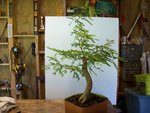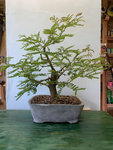Joe Dupre'
Omono
How different is seperating an air layer from the mother tree mid summer than collecting a tree from the wild? In late spring/early summer here, I airlayered a one year old collected honey locust that had really been vigorous. Last year, it had grown from a stump to a pretty decent tree considering the limited growing time. A little over 2 weeks ago, I seperated the airlayer and planted it in about 85% pine bark and 15% Napa 8822. At the time, I removed all foliage but a few tiny leaves. Fast forward to today and the tree is fully leafed out and thriving. Now the stump I removed it from was just a literal stump.......a little over 2" in diameter and 4" high and completely bare. Today it has one 25" long shoot coming out of the perfect place right at the cut line .
Now, if a seperated airlayer with precious few roots can happily survive and the stump can stand the trunk chop and happily survive, doensn't it seem like collecting and trunk chopping in mid-summer is a viable option? To be sure, honey locust is considered a "weed tree" here and is VERY hardy.
Just thinking.
Now, if a seperated airlayer with precious few roots can happily survive and the stump can stand the trunk chop and happily survive, doensn't it seem like collecting and trunk chopping in mid-summer is a viable option? To be sure, honey locust is considered a "weed tree" here and is VERY hardy.
Just thinking.



